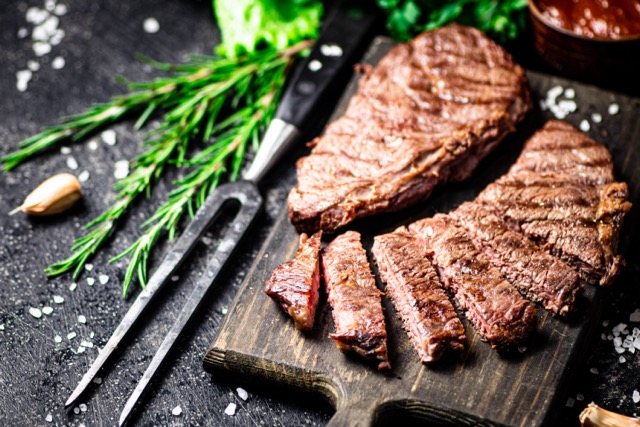Difference Between Dry Aged And Wet Aged Steaks At Chicago Steak Company
In the world of high-quality steaks, the aging process plays a pivotal role in determining flavor, tenderness, and overall quality. Two popular methods of aging steaks are dry aging and wet aging, each offering unique characteristics and benefits. At Chicago Steak Company, understanding these differences can greatly enhance your dining experience, whether you’re a seasoned steak lover or a casual enthusiast. This article explores the nuances between dry aged and wet aged steaks, helping you to make informed choices for your next meal.
Understanding Dry Aging: Process and Flavor Profile
Dry aging is a traditional method that involves hanging whole cuts of beef in a controlled, chilled environment for an extended period, typically ranging from 21 to 60 days. During this time, the outer layer of the meat forms a hard crust, which is later trimmed away, while the internal meat undergoes enzymatic breakdown. This process results in enhanced tenderness, as the natural enzymes break down muscle fibers, and deepens the flavor profile, concentrating the beefy notes.
The flavor profile of dry aged steaks is often described as nutty, earthy, and intensely beefy. This depth of flavor is attributed to the evaporation of moisture during the aging process, which concentrates the natural flavors of the meat. The unique characteristics of dry aged beef can vary significantly based on the aging period, the specific cut of meat, and the environmental conditions under which it was aged.
In addition to flavor and tenderness, dry aging also alters the meat’s texture, making it more complex and enjoyable to chew. This method is often preferred by steak connoisseurs who appreciate the distinctive taste and experience that comes with dry aged cuts. At Chicago Steak Company, patrons can explore a variety of dry aged options, each promising a remarkable culinary experience.
Exploring Wet Aging: Benefits and Characteristics
Wet aging, on the other hand, involves sealing cuts of beef in vacuum-packed bags and refrigerating them for a shorter period, typically ranging from a few days to a few weeks. This method utilizes the natural juices of the meat, allowing the beef to age in its own moisture, which helps maintain tenderness. Unlike dry aging, there is no moisture loss in wet aging, making it a more efficient process in terms of time and cost.
The flavor profile of wet aged steaks is generally milder compared to their dry aged counterparts. The beef retains a fresher taste, with a juiciness that comes from the vacuum-sealed environment. While wet aged steaks may lack some of the complex flavors associated with dry aging, they still provide a satisfying eating experience, particularly for those who prefer a more subtle beef flavor.
Wet aging is often viewed as a practical option for restaurants and consumers looking for high-quality steaks without the extensive aging period required for dry aging. At Chicago Steak Company, wet aged steaks are also available, ensuring a range of options for steak lovers who appreciate both methods of aging.
Key Differences Between Dry Aged and Wet Aged Steaks
The primary distinction between dry aged and wet aged steaks lies in the aging environment and the resulting flavor profiles. Dry aged steaks are exposed to air, allowing moisture to evaporate and concentrating flavors, while wet aged steaks are sealed in vacuum packs, preserving moisture and yielding a fresher taste. This fundamental difference impacts not only the flavor but also the texture of the meat.
Another notable difference is the aging duration and its effect on cost. Dry aging requires a longer period, often resulting in a higher price point due to the shrinkage of the meat and the labor involved. Wet aging, being a quicker process, generally offers a more affordable option without compromising on quality, making it a popular choice for many consumers.
In terms of culinary applications, dry aged steaks are often favored for grilling or pan-searing, where their robust flavors can shine. Wet aged steaks, with their tenderness and juiciness, are versatile and can be used in a variety of dishes, from quick weeknight dinners to elaborate culinary presentations. Understanding these differences can guide consumers in selecting the right steak for their specific needs and preferences.
Choosing the Right Steak: Tips for Steak Lovers
When it comes to choosing between dry aged and wet aged steaks, consider your personal taste preferences and the occasion. For those who enjoy bold flavors and a complex dining experience, dry aged steaks may be the ideal choice. It’s recommended to pair dry aged cuts with simple seasonings, allowing the rich flavors to take center stage without overwhelming the palate.
Conversely, if you’re looking for a tender, juicy steak that is easy to prepare, wet aged options can be a great fit. These steaks are often more forgiving for quick cooking methods, making them suitable for busy weeknights or casual gatherings. Experimenting with marinades and rubs can also enhance the flavor of wet aged steaks, providing variety in your meals.
Lastly, always consider the cut of meat. Some cuts, like ribeye and New York strip, are particularly well-suited for dry aging due to their fat content, which enhances flavor during the aging process. Meanwhile, leaner cuts such as filet mignon may benefit more from wet aging, preserving their natural tenderness. By understanding these nuances, steak lovers can better navigate their options at Chicago Steak Company and enjoy a tailored dining experience.
In summary, the differences between dry aged and wet aged steaks are significant, each offering unique attributes that cater to various tastes and preferences. Dry aging provides intense flavors and a complex texture, while wet aging ensures tenderness and juiciness. By understanding these distinctions, steak enthusiasts can make informed choices that elevate their dining experiences at Chicago Steak Company. Whether you opt for the boldness of dry aged or the freshness of wet aged, both methods promise to deliver high-quality steak that satisfies the palate.
